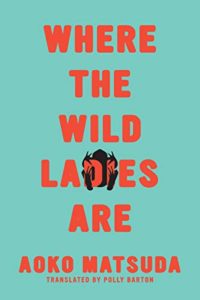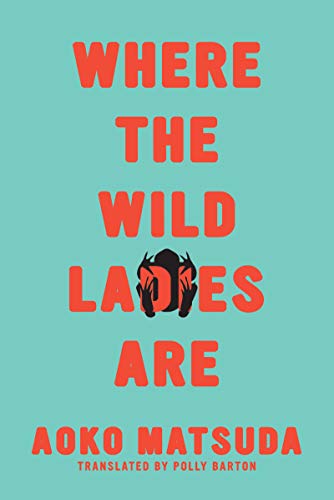Review by Tina deBellegarde
In Where the Wild Ladies Are (translated by Polly Barton) author Aoko Matsuda serves up eerie but uplifting feminist ghost stories. Each narrative has an original rakugo story, folk legend or kabuki play as its inspiration. The collection is enjoyable even without knowledge of the original stories, although luckily the US edition has a full appendix detailing the original tales. Unfortunately, the UK edition does not.
As the stories unfold, we slowly learn that Matsuda’s fierce and daring women are ghosts, each with a special skill or power. Matsuda challenges the tradition of the angry female spirit and shows us another side of her. This contemporary ghost is strong, but also independent, uninhibited and often upbeat. Matsuda gives these women a backstory so that their ghostliness and actions are understood in context, and any negativity associated with their behavior can be understood. They move through the world interacting with both the living and the dead. Death frees them, and as spirits they have more agency than they had alive.
Matsuda uses their stories as commentary on the gender disparity in Japanese culture, on the beauty standards imposed upon women, and on the unreasonable lengths women go through to live up to those standards.
A woman whose story, “Smartening Up,” opens at a depilatory salon, learns to transform into a hairy monster when she finally rejects the societal imposition that light-colored hair or no hair is more desirable. In a later story, we learn in passing that she has become more assertive and confident.
In “Quite a Catch,” a woman fishes a skeleton out of the river and later finds herself visited by the ghost of the skeleton. She bathes her visitor each night and they become lovers. She revels in how perfect the arrangement is, but also remembers how inflexible living with her boyfriend had been. In that relationship, she had stopped being herself and had become more concerned about gauging his needs and moods. This is one of the many instances in this book where women are rescued by other women.
In “Having a Blast” we are privy to a marriage from the perspective of both the husband and wife after death. First the husband confesses.
I don’t have any exceptional talents. After my death, I came to see that very clearly. It made me wonder what on earth I’d been playing at while I was still alive. People treated me well because I was a man – they treated me the way that men are treated. (p.218)
But the wife reminisces in a different way.
…I did go through a proper grieving period…But at some point I realized that it was actually easier being alone. It also meant a lot less housework. (p.223)
One of my favorites is “What She Can Do,” about a babysitting ghost. The mother has no support system in her family or community since she is faulted for leaving her bad marriage and selfishly “prioritizing her own needs.” The mother is forced to leave her child alone in order to go to work. The maternal ghost in this story slowly insinuates herself in the life of this single mother. A little at a time, so that the mother can get acclimated, she secretly cares for the child and cleans the house. Eventually, the mother comes to understand that her child is being cared for while she is away.
The main character in “A Fox’s Life” has a vulpine look and spent her early years following the most traditional route in her life choices. She never tried to outshine the men in her life even though she was brighter and more capable. She refused to further her education, took jobs catering to men, and looked the other way at their untoward advances. Later in life, as an empty-nester, she falls off a cliff and discovers upon landing that she is indeed a fox with all the freedom that affords. She realizes that she had been betraying herself, and embraces her newfound liberty.
The interlinkage of stories makes the collection feel much like a novel with a larger narrative arc and some revealed secrets. At first, it is not obvious that the stories are connected. Eventually, the layers peel away so that secondary, even tertiary characters in one story become the center of another. Once this pattern is noted, it adds an additional layer of pleasure as the reader searches for connections.
Japanese culture is known for the great paradox of embracing modernity while still respecting and partaking in the traditional culture. This is evident in Matsuda’s collection, where familiar ghosts are treated as commonplace. They are neither surprising nor frightening as they comfortably situate themselves in the modern world. By the end, you may decide that living with ghosts might be pleasant, and you may find yourself wishing to share your life with some, particularly such modern and relatable specters.
Listen to a BOA podcast with reviewer Tina deBellegarde as we discuss Where the Wild Ladies Are in the episode The Art of the Short Story.


